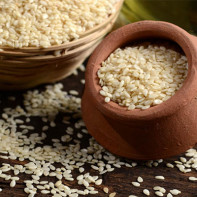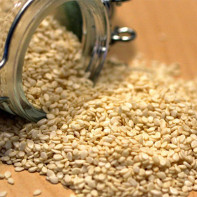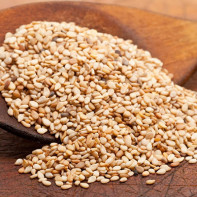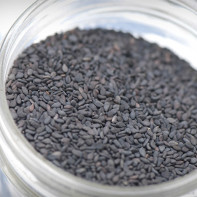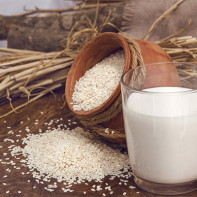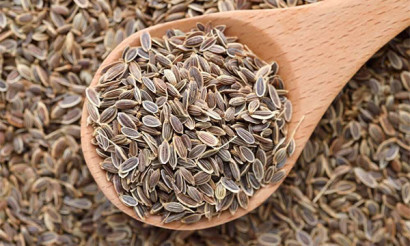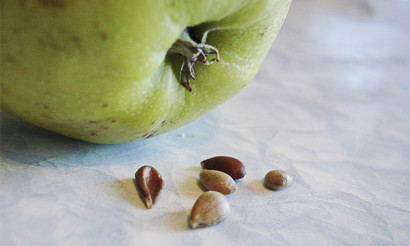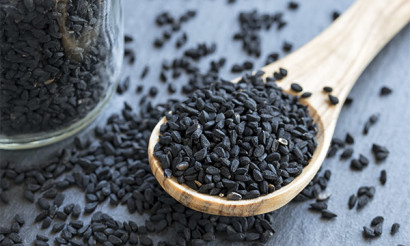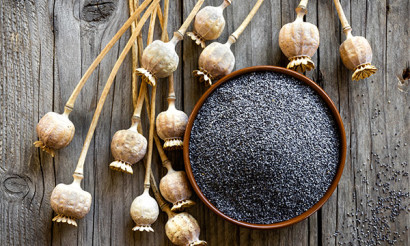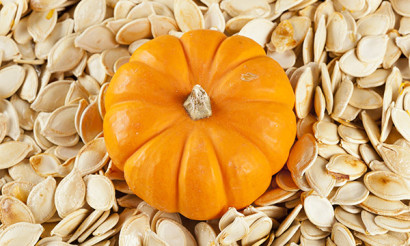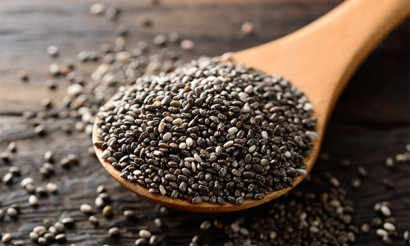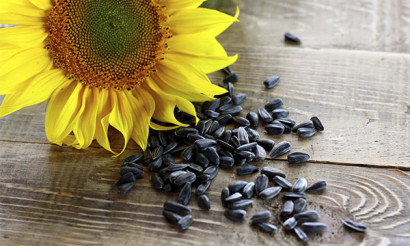Sesame seeds: useful properties and contraindications
Sesame is quite an ancient culture. The history of its cultivation is associated with many legends. According to some reports, the ancient Babylonians baked sesame pies and made sesame wines on its basis, from other sources we know that the Egyptians were actively using sesame seeds in medicine. In the Ancient East, sesame was attributed magical properties and considered it a source of eternal life.
- How and where sesame grows
- Types
- What is the difference between black and white sesame
- Which seeds are healthier: white or black.
- How much sesame seeds can be eaten per day
- Composition and Calories
- Useful properties of sesame seeds
- General benefits
- For Women
- For Men
- During Pregnancy
- Breastfeeding
- For Children
- How to take sesame seeds for weight loss
- Sesame seeds in medicine
- Diabetes mellitus
- Pancreatitis
- For Gastritis
- For Intestines
- For constipation
- For gout
- For hemorrhoids
- For Bones
- Sesame in cosmetology
- For Face
- For Hair
- What is Sesame Oil Good for?
- Sesame Urbech Benefit
- Sesame Halva: Benefits and Harms
- Sesame seeds in cooking
- How to cook sesame milk
- How to Make Sesame Stuffing
- How to Toasted Sesame Seeds
- Recipe for sesame porridge
- What can be substituted for sesame seeds?
- Hazards and Contraindications
- Symptoms of allergy to sesame seeds
- How to Choose and Store Sesame Seeds
- How to Eat Sesame Seeds to Absorb Calcium
- How to Sprout Sesame Seeds
- Can I Give Sesame to Animals
- Interesting facts about sesame
How and where sesame grows
Sesame is a heat-loving plant, for this reason it is more popular in southern countries. At one time, the first to grow sesame were the Hindus, Pakistanis and inhabitants of North Africa. A little later the culture spread to Southeast and Central Asia, as well as in the Caucasus.

The plant can grow to 200 cm, in the conditions of the average strip - up to 75 cm. There are both annual varieties and perennials. Sesame flowers are white, pink or blue. Sesame flowers bloom for only 1 day, the plant is self-pollinated, after which it produces green pods containing about 75-85 seeds.
Types
There are quite a few species of sesame (about 35). The most common types of sesame are:
- White - used, as a rule, in baking, and the seeds do not need to be processed, they can be consumed in their natural form.
- Black - has medicinal properties. The seeds contain much more calcium than the peeled grains. It is used to make oil or in ground form served with rice.
- Brown sesame is used to make butter and is also used to make candies and other sweets.
How black sesame differs from white sesame
White sesame is a grain peeled from the husk. It is used as a sprinkle on baked goods. The grains have a fairly soft texture and a bright sweet flavor.
Black sesame has medicinal properties, so it is considered more useful for the body. The seeds are used in a variety of applications, from cosmetology to cooking. The seeds have a bitter taste. Black sesame seeds are used to make oil and can also be used with rice and vegetables.
Which seeds are healthier: white or black?
Black sesame has a wider range of medicinal properties compared to white sesame, so it is believed to be healthier.
How much sesame seeds can be eaten per day
The optimal daily dose for an adult is no more than 3 tablespoons. It is important to make sure that the seeds are thoroughly chewed, otherwise it will be difficult for the body to assimilate this product. For example, you can grind the seeds in a coffee grinder or roast them.
It is better to consume the seeds in the morning on an empty stomach. It is not recommended to eat the daily dose at once, because nausea and attacks of thirst can occur.
Composition and calories
In 100 g of the product contains:
- Calories - 565 kcal.
- Protein - 19.4 g.
- Fats - 48,7 g.
- Carbohydrates - 12,2.
- Sesame is rich in:
- Potassium (497 mg).
- Calcium (1474 mg).
- Magnesium (540 mg).
- Sodium (75 mg).
- Phosphorus (720 mg).
- Iron (16 mg).
Useful properties of sesame seeds
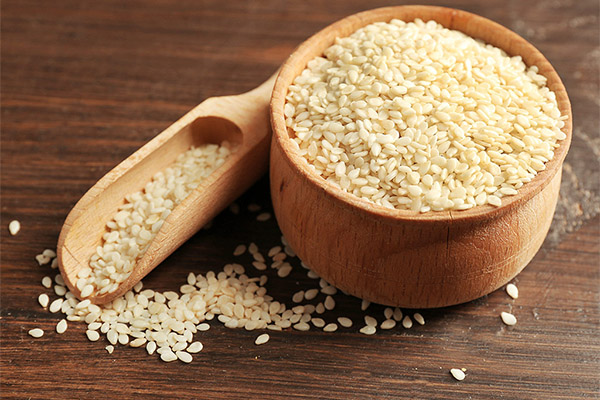
General benefits
- Health benefits for the hair. The fatty acids in this product are a natural hair growth stimulant. They not only nourish the scalp, but also help to strengthen the follicles. People suffering from hair loss are recommended to consume sesame seed oil. This product helps maintain the natural color of the hair, thus preventing premature graying.
- Source of protein. The seeds are rich in protein, 100 g of the product contains 19 g. Therefore, sesame is very often present in many diet recipes.
- Cancer prevention. The seeds contain a large number of minerals. One of them is magnesium, which is known for its anti-cancer properties.
- Reducing blood sugar levels. Grains are rich in magnesium, which helps the body control glucose levels. Therefore, this product is allowed and even recommended for people with diabetes.
- Prevention of heart disease. Sesame has anti-atherogenic properties, so it is very useful for heart disease. In addition, the seeds contain oleic acid, which helps control cholesterol levels. Consequently, regular consumption of the seeds reduces the likelihood of stroke.
- Anemia cure. Sesame seeds are rich in iron. Therefore, sesame is a natural cure for anemia.
- Aids in the treatment of rheumatoid arthritis. The grains contain copper, antioxidant enzymes and compounds that help reduce joint pain and inflammation.
- A cure for respiratory diseases. Due to the presence of magnesium in the seeds, sesame can act as a treatment for respiratory diseases. The product is recommended to be consumed by people suffering from asthma, as it will help alleviate the symptoms of such illnesses.
- DNA protection. Sesamol is an antioxidant found in sesame seeds that successfully fights free radicals and protects DNA from damage.
- Digestive Support. The seeds play an important role in maintaining the proper functioning of the digestive system. As a good source of fiber, seeds help the colon do its job and ensure smooth bowel function.
- Bone Health Guarantee. Sesame seeds contain significant amounts of zinc. This mineral supports bone health and prevents osteoporosis.
- Supporting oral health. Another great thing about this product is that it is very beneficial to oral health. The grains help clean plaque from your teeth and even maintain their whiteness. Therefore, it is recommended to regularly rinse your mouth with sesame seed oil.
For Women
Sesame seeds are rich in active substances such as phytosterols. They have beneficial effects on the female body. Phytosterols promote rejuvenation, lower cholesterol levels, enhance immunity and support the endocrine system. They also have a favorable effect on the female reproductive system.
For men
The use of sesame has a beneficial effect on the male body, especially the seeds are useful for potency. Sesame helps to increase the number and motility of sperm, and sometimes it is even prescribed as a treatment for male infertility. Sesame also supports the immune system and helps in the recovery of the body.
In Pregnancy
Some people believe that pregnant women should not consume sesame because it can negatively affect the baby or even lead to miscarriage. However, there is no scientific evidence to support this.
It is known that sesame seeds have important nutrients such as iron and protein, which are good for both the pregnant woman and her fetus. In general, sesame seeds are not harmful to expectant mothers. However, not every body reacts to the same foods in the same way. If stomach upset occurs after eating sesame seeds, it is necessary to exclude this product from the diet. Some experts state that it is better not to eat sesame during the first trimester, as it can cause nausea.
When breastfeeding.
Sesame contains calcium. This mineral is necessary during the period of breastfeeding, as it helps to increase the amount of milk. But again, it is worth remembering that when consuming the product, you need to stick to reasonable rates. Women who suffer from high blood clotting or thrombophlebitis should not consume sesame.
For Children
Sesame is useful for both adults and children, the only difference is the dosage. Adults can consume about 2-3 tablespoons per day, children - no more than 1 teaspoon. The norm of consumption is not recommended to exceed, because it can have a negative impact on the children's body. Include sesame in children's diet is allowed from 1 year, but you need to be very careful and monitor the condition of the baby.
Many pediatricians recommend giving children sesame halva, which perfectly increases the level of hemoglobin in the body.
How to take sesame for weight loss
Sesame helps to fight extra pounds. The seeds not only have a pleasant nutty taste, but also help suppress appetite, give a feeling of satiety and hydrate the intestines. Sesame is recommended as part of cold dishes. You can also simply chew it and eat it right before a meal (15 g of seeds up to 3 times a day), and you should wash down the seeds with warm water.
Sesame Seeds in Medicine
In medicine, sesame seeds are used for hypertension, joint inflammation, asthma, as well as heart disease and gastrointestinal problems.
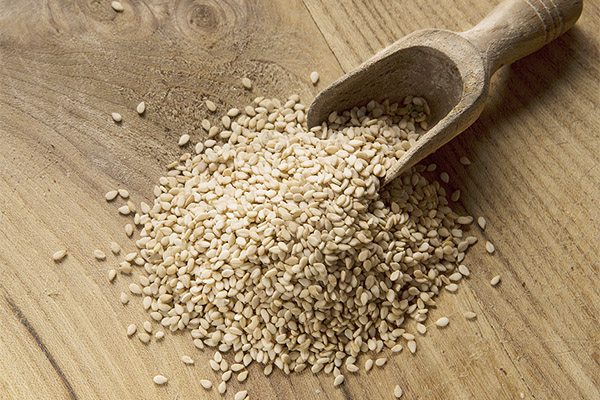
For Diabetes Mellitus.
People with diabetes are allowed to use sesame seeds (up to 2 teaspoons per day). The seeds can be added to vegetable salads or meat dishes. As for baked goods sprinkled with sesame seeds, it is recommended to exclude them from the diet.
Important: The glycemic index of sesame seeds is 35 units.
In case of pancreatitis
During periods of exacerbation of the disease, it is forbidden to consume sesame seeds. They are quite difficult to digest, and also contain a lot of calories. But if we are talking about periods when the condition is more or less stabilized, or about a significant weakening of the disease, the acceptable daily rate is 30 grams.
For gastritis
When gastritis worsens, it is necessary to exclude sesame from your diet. Since sesame promotes irritation of the stomach, even in periods of remission it is not recommended to eat this product. In extreme cases, sometimes you can add a small amount of seeds to dishes.
For the Intestines
Sesame contains enzymes that have beneficial effects on the GI tract. They participate in the process of assimilation of important elements, it facilitates the work of the intestine, prevents the accumulation of toxins and deposition of fat, which is reflected in body weight.
For constipation
Sesame is a natural enveloping and wound healing agent, and also helps to cope with constipation. To get rid of constipation, you need to consume sesame seeds on an empty stomach, it will help cleanse the intestines and flush out the accumulated toxins.
For gout
It is not recommended to consume sesame seeds for gout, but it is allowed. You can add the grains to salads, but it is worth remembering that sesame contains oxalates. Excessive consumption of sesame and, consequently, ingestion of large amounts of oxalates, can cause a worsening of gout, so moderation should be observed.
In hemorrhoids
When hemorrhoids, sesame decoction can be washed over the problem area. To do this, pour 2 tbsp. sesame 0.5 l boiling water, cook over low heat for 4-5 minutes. Then the broth should infuse in a warm place until it cools. After that, the decoction can already be used as a solution for bathing or wiping the anal passage.
For Bones
Sesame contains a considerable amount of zinc. This mineral is known to help thicken bone tissue and prevent osteoporosis.
Sesame in cosmetology
Sesame is widely used in the field of cosmetology, as it has a rich chemical composition. This product is used in hair and skin care.

For face
Mask for maintaining youthful skin
Ingredients:
- apple - 1 pc;
- Sesame oil - 1 tsp;
How to prepare:
- Peel the apple and grate the pulp.
- Add sesame oil to the apple.
- Apply the mixture on your face.
- Wait for 15 minutes.
- Wash face with water.
Mask for firm and fresh skin
Ingredients:
- sesame oil;
- honey;
- grape juice.
How to prepare:
- Mix oil, honey and juice in equal proportions.
- Apply the mixture to the face.
- Allow the mixture to work for 15 minutes.
- Wash the face with water.
Mask for problem skin
Ingredients:
- sesame oil - 1 tsp;
- rice - 100 gr;
- pear - 1 piece.
How to prepare:
- Boil the rice over low heat until it is pulpy (do not add salt).
- Mash the pear with oil.
- Add the mixture to the rice pulp.
- Apply the warm mixture to problem areas.
- Wait for 20 minutes.
- Rinse off the rest. To remove the mask, it is recommended to use chamomile decoction.
For hair
Hair nourishing mask
You will need according to the recipe:
- sesame oil - 30 ml (for medium length);
- lemon juice - 3 tsp;
- cap.
How to prepare:
- Mix the oil with lemon juice.
- Apply the mixture to the entire length of the hair and put a cap on.
- Wait 2-3 hours (you can leave it for the night).
- Wash your hair.
Hair restoration mask
What you need:
- warm honey (liquid) - 2 tbsp;
- chicken egg yolk - 2 pcs;
- Sesame oil - 2 tbsp;
- cap.
How to prepare:
- Mix honey, egg yolk and oil.
- Spread the mixture over the entire length of the hair and put on a cap.
- Wait 30 minutes to 2 hours.
- Wash your hair.
How sesame oil is useful
Sesame seed oil is a preventive agent against various infectious diseases. This product also helps the body to maintain bone health, controls blood pressure, speeds up metabolism and blood circulation, moisturizes the skin, relieves pain from arthritis and helps with constipation.

Specialists highlight the useful properties of the oil:
- Maintains skin health. The oil helps in the treatment of skin inflammations. By penetrating deep into the skin, the oil has a detoxifying effect, which helps to keep the skin young and healthy.
- It strengthens bones. With regular consumption of the product, you can avoid osteoporosis and many other age-related diseases associated with weakening bones.
- Lowers blood pressure. The oil helps to lower blood pressure. A study conducted in India showed that patients with high blood pressure who regularly consumed sesame oil returned to normal values. It was also documented that the majority of study participants lost weight during this period. It is also worth noting that the participants' blood pressure increased when they stopped taking the oil.
- Slows down aging. Sesame prevents oxidation of skin cells and promotes skin rejuvenation. The seeds contain antioxidants that prevent the early appearance of wrinkles.
- Relieves arthritis pain. Copper is a key mineral that helps fight various swellings. The oil contains copper, so you can use it to reduce the pain caused by arthritis. In addition to this, the mineral also helps strengthen bones and joints.
- It helps with constipation. Consumption of one or two spoonfuls of sesame oil a day helps lubricate the intestines, which helps relieve constipation.
- Prevention of hangovers. The sesamin present in sesame oil helps the liver to get rid of the effects caused by alcohol consumption.
- Reduces sodium levels. A study by the Yale Journal of Biology found that taking sesame oil not only helps lower blood pressure, but also lowers sodium levels in the body.
The Benefits of Sesame Urbech
Urbech is the name given to the paste obtained by milling dried sesame seeds with stone grinders. It turns out quite a thick mass of milky color. As a result of such treatment raw material does not lose its useful properties. The product is usually stored in glass jars in a cool, dry place at room temperature.

100 g of the product contains 575 kcal. Urbache is high in calcium, which promotes growth and strengthens bones, nails, and teeth. Fiber, which is present in Urbech, supports the function of the gastrointestinal tract.
Urbech is a natural prophylactic against constipation. This product is approved for use by people suffering from celiac disease, as it does not contain gluten.
Sesame halva: benefits and harms
Sesame halva contains a large number of vitamins and minerals. This is a highly nutritious product, which contains zinc, calcium, manganese, magnesium, sodium and other compounds. It also contains vegetable protein, fats and carbohydrates. People with diseases of the cardiovascular system can particularly benefit from its consumption. It is also worth noting that the fatty acids it contains, normalize fat, lipid metabolism.
Halva is quite caloric, with 500 kcal per 100 grams of product. If you do not comply with the norm of consumption of the product, it can have a negative impact on the digestive system, as well as on the teeth. After the use of halva in children can manifest diathesis. For diabetes or obesity, this product is not recommended to eat.
Sesame seeds in cooking
Sesame seeds have a nutty, slightly sweet taste. After roasting, their flavor becomes more intense. Therefore, in the culinary field sesame seeds are often used as a spicy flavoring.
Whole seeds, sesame oils and powders made from the grains are the most popular, and fresh and sauerkraut leaves are also used. The seeds act as a decoration and flavoring for baked goods, cookies, and crackers. Sesame powders are used in meat and mushroom soups, vegetable casseroles, as well as dessert dishes, gravy and sauces.
How to make sesame milk
Ingredients:
- uncooked sesame - 100 g;
- honey - 2 tsp;
- water - 1 l.
How to prepare:
- Soak sesame in cold water (7-8 hours).
- Drain the water, wash the seeds. To the seeds add honey and water (1 cup).
- Grind the seeds in a blender until smooth.
- Add water, mix the mixture with a blender.
- Adjust the density of the milk by adding water (you can also add a pinch of vanilla).
- Strain the resulting mass through gauze or a strainer.
The milk will have a slight sweet and nutty flavor. You can use it when making cocoa, or add it to coffee.
How to make sesame seeds
Ingredients:
- sesame - 250 g;
- honey - 250 g;
- sugar - 50 gr.
How to prepare:
- In a saucepan add honey and sugar, stir, put to boil over low heat (10 minutes).
- Place the sesame seeds in a dry heated frying pan and stir-fry them until they turn golden (1-2 minutes). Then add the toasted seeds to the honey-sugar mixture and stir to combine.
- Moisten a parchment sheet with water and spread the mixture on it. Spread it on the surface and let it cool.
- After the mass has cooled, cut the kozinaki into squares.
How to Toasted Sesame Seeds
- Pour the seeds into a dry pan and fry over medium heat.
- Stir with a wooden spatula to toast the seeds. Once the pan is hot, the heat can be turned down to low. Wait for the seeds to turn golden (3-5 minutes).
- Once the seeds have reached the desired consistency, transfer them to a plate (preferably flat).
- Wait for the sesame seeds to cool.
Sesame porridge recipe
Ingredients:
- sesame seeds - 30 g;
- banana - 1 pc;
- water (boiled) - 80 ml.
How to prepare:
- In the evening, pour the seeds with water (you can directly in a blender).
- In the morning, grind the seeds in a blender (about 2 minutes), add banana and stir the mass in a blender (1 minute).
- The resulting porridge on a plate.
How you can substitute sesame
In fact, it is not easy to find a substitute for sesame seeds, as this product has a special taste. The most suitable alternatives are sunflower seeds or poppy seeds.
Harms and contraindications
In some cases, sesame seeds can cause allergies. The main danger is the occurrence of anaphylaxis, which can manifest itself in various forms.
Anaphylaxis is a body reaction that results from the production of large amounts of powerful chemicals. These chemicals cause what in medical circles is called anaphylactic shock. Blood pressure can drop drastically and breathing can become difficult.
Sesame is not recommended for people who have high blood clotting, as well as those suffering from thrombosis, urolithiasis.
Symptoms of sesame allergy
Sesame allergy (or anaphylaxis) can manifest itself with a number of symptoms. Here are some of them:
- difficulty breathing;
- coughing;
- nausea;
- abdominal pain;
- vomiting;
- hives;
- itching in the mouth;
- Facial redness.
People with gout and Wilson's disease are advised to eliminate sesame from their diet. To avoid allergic reactions, pregnant and lactating women need to observe the rate of consumption of sesame.
How to choose and store sesame seeds
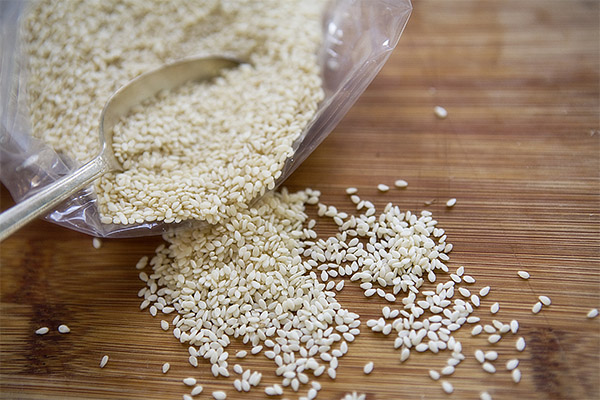
- When buying sesame seeds, you should pay your attention to the color and smell of the seeds. The grains should have a light color without a stale odor, and you want the seeds to be crumbly.
- Take into account the fact that unpeeled seeds have a longer shelf life.
- It is recommended to buy packaged sesame seeds.
Sesame should be stored in a dry, ventilated room without access to sunlight. The recommended storage temperature is about 0 degrees or lower.
How to eat sesame to assimilate calcium
As is known, sesame contains calcium, but this mineral is not always absorbed by the body. It is worth noting that processed seeds contain 10 times less calcium than whole seeds, so it is recommended to choose dry, crumbly and unprocessed grains.
The product can be stored for about 6 months in a hermetically sealed container in a dark and cool place. If you want to preserve the useful components of sesame seeds (including calcium), roast the seeds gently and over low heat.
Here are a few rules to help absorb calcium:
- Calcium is better absorbed if there is enough vitamin D in the body. To get it, it is necessary to walk as often as possible in sunny weather (during this time the body is exposed to ultraviolet rays, which contributes to the production of vitamin D).
- It is also worth taking care that the body has enough phosphorus. Therefore it is recommended to combine calcium intake with fish and seafood, fresh herbs and cottage cheese.
- It is necessary to watch the acid balance in the stomach.
- Physical activity should not overload the body.
- It is worth limiting the consumption of certain products, namely carbonated drinks, coffee, salt, sorrel and spinach.
How to sprout sesame
You can germinate sesame with the help of jars or an electric sprouter (a device that controls the temperature and humidity).
What you need to do:
- Sort the seeds from pebbles and debris, then rinse thoroughly under running water. Then place the seeds in the prepared jar. If there is a sprouter, just put the sesame seeds in special containers.
- Then pour the seeds with clean water (room temperature) and leave them in this form for 5-8 hours. The seeds will absorb the moisture, which they will need for the germination process.
- Drain the water and set the jar upside down (this way the sesame seeds will not get moldy).
The seeds will germinate in about a day. And here it is important to note that the longer germination lasts, the more bitter they will be.
When the sprouts reach a height of 3-5 mm, place them in the refrigerator so that the growth process is slowed down. This will extend the period in which you can consume sesame (about 3 days).
Important: It is not recommended to consume such sesame, whose sprouts have reached a length of more than 5 mm.
Can I give sesame seeds to pets?
Sesame is considered a very good ingredient in cat and dog food. It is an excellent source of vegetable fat as well as protein and fiber. However, it should be monitored to see if the consistency of the animal's stools changes.
Interesting facts about sesame
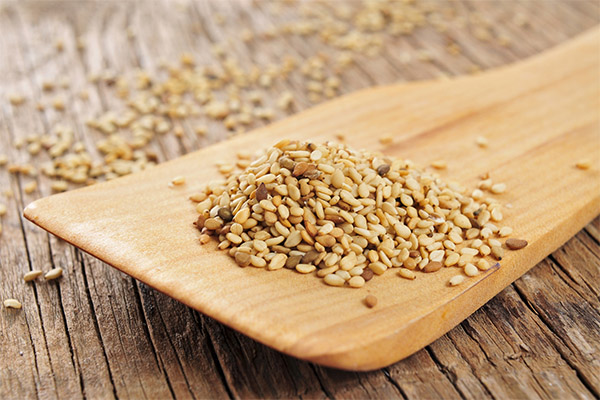
- The leading producers of sesame seeds in the world are India, Myanmar, China, Nigeria, and Tanzania.
- Since ancient times, women have consumed sesame seeds to preserve their beauty and youthfulness. It is known from some sources that Roman soldiers consumed sesame seeds to preserve their strength.
- Sesame seeds were brought to America by African slaves in the 17th century, and it was sesame oil that was particularly popular in the 1930s.
- In ancient times, the Arabs used sesame seeds and sesame oil to prepare a variety of dishes that provided nourishment during long caravan journeys across the hot, dry desert.
- Sesame seeds are gluten-free and therefore can be consumed by people with celiac disease.
- Sesame seeds contain special fibers called sesamine and sesamolin, which can help lower cholesterol levels as well as help regulate blood pressure and are an excellent source of vitamin E.
- In India, sesame seeds are used in sacred rituals and are a symbol of immortality. During funerals, Indians carry vases of sesame seeds, it is believed to help the deceased go to the other world.
- Sesame oil is extremely popular in North Africa, the Middle East, Turkey and Greece. Compared to peanut butter, it has more calcium, fiber, and less saturated fat.
- Zinc, magnesium, iron, phosphorus, selenium, and manganese are all compounds found in sesame. This product is also a source of calcium. Sesame seeds are rich in micronutrients that the human body needs for normal functioning.
- Cultivation of sesame seeds is an ancient tradition. Some scholars claim that 4,000 years B.C. people attempted to use the crop. The seeds are mentioned in Egyptian medical books written in 1550 BC.
- In Hindu language, the word "oil" comes from the Sanskrit word for sesame.
Many people have probably heard the expression "Sim-sim, open up. These are the exact words uttered by the main character in the tale of Ali Baba and the Robbers. In translation, the word sesame means exactly sesame. The Arabs believed that sesame had magical powers, and the magic spell "Sim-sim, open up" is a bud of ripe sesame that opens abruptly. In doing so, there is also a release of seeds. Sesame is one of the so-called treasures of the world, it is present in the list of the most useful and popular products.
«Important: All information on this site is provided for informational purposes only purposes. Before applying any recommendations, consult a health care professional. specialist. Neither the editors nor the authors shall be liable for any possible harm caused by materials."


